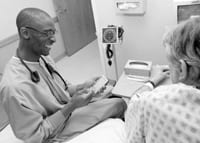HMC Pilots New Wireless Technology New Equipment Means Shorter Hospital Stays, More Efficient Medical Environment
Life has become simpler for RN Emmanuel (Neba) Cheo, and safer for his patients on Holyoke Medical Center’s South-4 surgical unit, thanks to the real-time, wireless, palm-sized ‘Point of Care’ software technology the hospital is piloting.
A recent overnight shift found Cheo at a patient’s bedside, pointing-and-clicking with a thin stylette, rather than entering patient information by pressing buttons on his handheld computer.
This meant less time spent documenting information at computer stations and more time spent with the patient at the bedside, he said, resulting in better and more efficient treatment within a safer environment.
Not only could Cheo read patients’ laboratory results minutes after they were entered into the electronic medical record, but he immediately knew if they were abnormal because they were color-coded pink. He could also instantly document his intervention, note allergies, and contact the patient’s physician — all without leaving the bedside.
Such technology made all the difference for one of RN Dorina Nagy’s South-1 Telemetry patients late one night.
“I had a patient whose blood pressure was down quite low. I was giving her meds and a bolus of fluid. I popped right into the computer and logged her blood pressure and logged right in what I was doing. After I got her stabilized, I had nothing to chart. I could stay with her,” said Nagy, a nurse of 18 years who has experienced three generations of patient-documenting technology at HMC.
The ‘Personal Digital Assistants (PDAs)’ refresh every five minutes, updating information entered from anywhere in the hospital via a wireless radio frequency network, giving the latest information on the patient. This is a vast improvement over the last two generations of patient-record-documenting technology, said 24-year nurse Sue Sullivan, HMC’s Information Systems Manager of Application Services.
“This provides nurses with the chance to do more bedside patient care, rather than having to leave the patient and go to the nursing station to do charting,” she said.
For the last year, HMC’s Intensive Care Unit nurses have been utilizing wireless laptop computers. By the end of February, nurses and nursing assistants in HMC’s Telemetry and Medical/Surgical units as well as the Birthing and Transitional Care centers will be ‘live’ on the new PDAs, communicating in real time, said Sullivan.
“It is intuitive; never before have I seen technology that is so simple to learn, safer for patients and hospital staff, and so dramatically efficient,” she said.
Debbie Lajoie, a nurse of 16 years, had similar thoughts. “It’s amazing. It’s instantaneous. It makes me want to get back out there and work for awhile,” said Lajoie, who, as project leader, is training the pilot group of 11 nurses and nurses’ aides to use the PDAs.
The PDAs are the latest technology from MEDITECH, the company that introduced the former handheld computers that nurses used for over a decade. HMC is the first of four ‘beta sites’ — hospitals piloting the new software in the United States.
Mark Cameron, MEDITECH’s development manager of nursing products, said the devices were specifically designed for nurses.
“We tried to identify those tasks that the nurse would want to do at the bedside,” said Cameron, including entering a patient’s vital signs, allergies, interpreting laboratory results, viewing orders, medications and documenting interventions.
HMC’s Vice President of Inpatient Services Clark Fenn said that preventing delays in communication greatly enhances nurses’ ability to respond and intervene quickly to a patient’s needs.
Carl Cameron, HMC’s manager of Information Systems, oversaw the installation of the PDAs and assured the quality and security of the wireless network.
The purchase of the wireless nodes, which transmit data, was made possible through a generous donation from long-time hospital supporter Barbara Bernard of Holyoke, in the name of Dr. Thomas Judd, chairman of the Physicians Advisory Committee on Information Technology. Additional funding for the project, also in honor of Dr. Judd, was provided by the late Mrs. Richard Nickerson, also a longtime supporter of Holyoke Medical Center.
Judd, who utilizes a wireless tablet computer, said he feels the technology is “timely and beneficial” in providing a higher quality of care at HMC.
“It integrates the exchange of data and it will be helpful in the future for additional projects we’re planning. It’s beneficial for patient safety because having the diagnostic and treatment information readily available reduces errors and eliminates delays, and helps to maximize responsiveness to patients’ needs and ultimately, shorten patients’ hospital stays,” he said.

